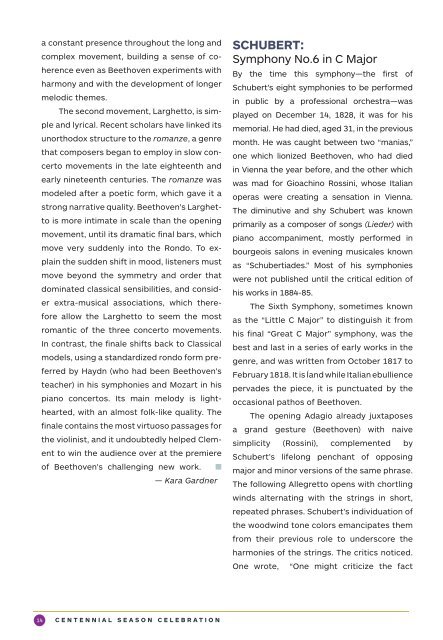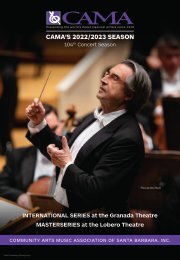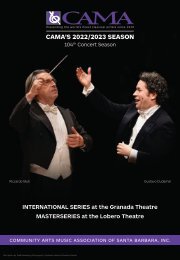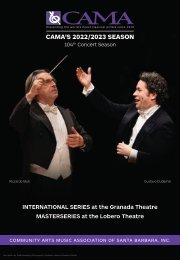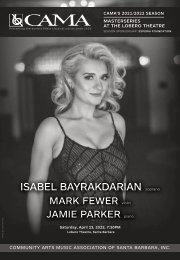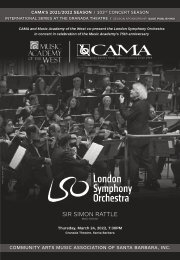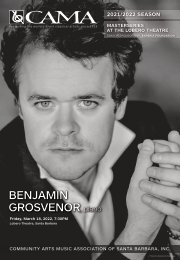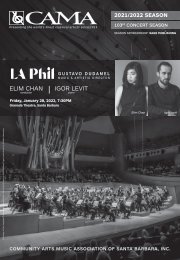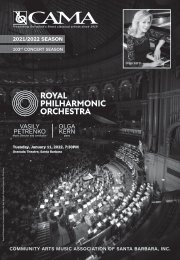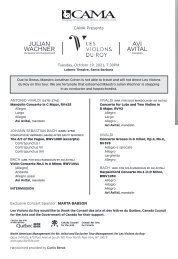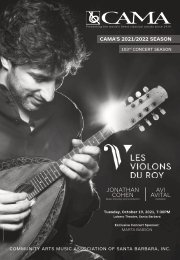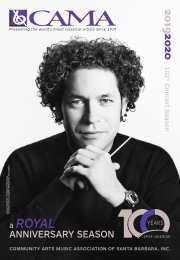Philharmonia Baroque Orchestra—February 5, 2019—CAMA's International Series at The Granada Theatre—Centennial Season
TUESDAY, FEBRUARY 5, 2019, 8:00 PM Philharmonia Baroque Orchestra Nicholas McGegan, Music Director Rachel Barton Pine, violin Renowned as an interpreter of a wide range of classical music, English-born conductor Nicholas McGegan was appointed Officer of the Most Excellent Order of the British Empire (OBE) for “services to music overseas” by Queen Elizabeth in 2010. He has served since 1985 as Music Director of the Philharmonia Baroque Orchestra, establishing it as the leading period performance ensemble in the United States. The Philharmonia is dedicated to capturing the spirit and distinctive sound of music from the Baroque to the early Romantic periods using authentic instruments and stylistic conventions. American violinist Rachel Barton Pine, the youngest-ever gold medal winner of the International Johann Sebastian Bach Competition, will join the orchestra for the rarely performed Violin Concerto in D major of violinist Franz Clement (one of Beethoven’s closest friends, for whom he composed his own Violin Concerto in D major). PROGRAM: Wolfgang Amadeus Mozart: Overture to The Marriage of Figaro, K.492 Franz Clement: Violin Concerto in D Major (1805) Franz Schubert: Symphony No.6 in C Major, D.589 PRE-CONCERT LECTURE BY ANDY RADFORD, MUSIC DIRECTOR, SANTA BARBARA YOUTH SYMPHONY; AND LECTURER, WOODWIND, BRASS & PERCUSSION PROGRAM, UCSB DEPARTMENT OF MUSIC Lecture will begin at 7:00 PM; doors to The Granada Theatre will open for the lecture at 6:45 PM. Lecture seating is limited to the first 100 patrons. First come, first served. #CAMASB #CAMAat100 #CAMACentennial
TUESDAY, FEBRUARY 5, 2019, 8:00 PM
Philharmonia Baroque Orchestra
Nicholas McGegan, Music Director
Rachel Barton Pine, violin
Renowned as an interpreter of a wide range of classical music, English-born conductor Nicholas McGegan was appointed Officer of the Most Excellent Order of the British Empire (OBE) for “services to music overseas” by Queen Elizabeth in 2010. He has served since 1985 as Music Director of the Philharmonia Baroque Orchestra, establishing it as the leading period performance ensemble in the United States. The Philharmonia is dedicated to capturing the spirit and distinctive sound of music from the Baroque to the early Romantic periods using authentic instruments and stylistic conventions. American violinist Rachel Barton Pine, the youngest-ever gold medal winner of the International Johann Sebastian Bach Competition, will join the orchestra for the rarely performed Violin Concerto in D major of violinist Franz Clement (one of Beethoven’s closest friends, for whom he composed his own Violin Concerto in D major).
PROGRAM:
Wolfgang Amadeus Mozart: Overture to The Marriage of Figaro, K.492
Franz Clement: Violin Concerto in D Major (1805)
Franz Schubert: Symphony No.6 in C Major, D.589
PRE-CONCERT LECTURE BY ANDY RADFORD, MUSIC DIRECTOR, SANTA BARBARA YOUTH SYMPHONY; AND LECTURER, WOODWIND, BRASS & PERCUSSION PROGRAM, UCSB DEPARTMENT OF MUSIC
Lecture will begin at 7:00 PM; doors to The Granada Theatre will open for the lecture at 6:45 PM.
Lecture seating is limited to the first 100 patrons. First come, first served.
#CAMASB #CAMAat100 #CAMACentennial
You also want an ePaper? Increase the reach of your titles
YUMPU automatically turns print PDFs into web optimized ePapers that Google loves.
a constant presence throughout the long and<br />
complex movement, building a sense of coherence<br />
even as Beethoven experiments with<br />
harmony and with the development of longer<br />
melodic themes.<br />
<strong>The</strong> second movement, Larghetto, is simple<br />
and lyrical. Recent scholars have linked its<br />
unorthodox structure to the romanze, a genre<br />
th<strong>at</strong> composers began to employ in slow concerto<br />
movements in the l<strong>at</strong>e eighteenth and<br />
early nineteenth centuries. <strong>The</strong> romanze was<br />
modeled after a poetic form, which gave it a<br />
strong narr<strong>at</strong>ive quality. Beethoven's Larghetto<br />
is more intim<strong>at</strong>e in scale than the opening<br />
movement, until its dram<strong>at</strong>ic final bars, which<br />
move very suddenly into the Rondo. To explain<br />
the sudden shift in mood, listeners must<br />
move beyond the symmetry and order th<strong>at</strong><br />
domin<strong>at</strong>ed classical sensibilities, and consider<br />
extra-musical associ<strong>at</strong>ions, which therefore<br />
allow the Larghetto to seem the most<br />
romantic of the three concerto movements.<br />
In contrast, the finale shifts back to Classical<br />
models, using a standardized rondo form preferred<br />
by Haydn (who had been Beethoven's<br />
teacher) in his symphonies and Mozart in his<br />
piano concertos. Its main melody is lighthearted,<br />
with an almost folk-like quality. <strong>The</strong><br />
finale contains the most virtuoso passages for<br />
the violinist, and it undoubtedly helped Clement<br />
to win the audience over <strong>at</strong> the premiere<br />
of Beethoven's challenging new work. n<br />
— Kara Gardner<br />
SCHUBERT:<br />
Symphony No.6 in C Major<br />
By the time this symphony—the first of<br />
Schubert’s eight symphonies to be performed<br />
in public by a professional orchestra—was<br />
played on December 14, 1828, it was for his<br />
memorial. He had died, aged 31, in the previous<br />
month. He was caught between two “manias,”<br />
one which lionized Beethoven, who had died<br />
in Vienna the year before, and the other which<br />
was mad for Gioachino Rossini, whose Italian<br />
operas were cre<strong>at</strong>ing a sens<strong>at</strong>ion in Vienna.<br />
<strong>The</strong> diminutive and shy Schubert was known<br />
primarily as a composer of songs (Lieder) with<br />
piano accompaniment, mostly performed in<br />
bourgeois salons in evening musicales known<br />
as “Schubertiades.” Most of his symphonies<br />
were not published until the critical edition of<br />
his works in 1884-85.<br />
<strong>The</strong> Sixth Symphony, sometimes known<br />
as the “Little C Major” to distinguish it from<br />
his final “Gre<strong>at</strong> C Major” symphony, was the<br />
best and last in a series of early works in the<br />
genre, and was written from October 1817 to<br />
February 1818. It is Íand while Italian ebullience<br />
pervades the piece, it is punctu<strong>at</strong>ed by the<br />
occasional p<strong>at</strong>hos of Beethoven.<br />
<strong>The</strong> opening Adagio already juxtaposes<br />
a grand gesture (Beethoven) with naive<br />
simplicity (Rossini), complemented by<br />
Schubert’s lifelong penchant of opposing<br />
major and minor versions of the same phrase.<br />
<strong>The</strong> following Allegretto opens with chortling<br />
winds altern<strong>at</strong>ing with the strings in short,<br />
repe<strong>at</strong>ed phrases. Schubert’s individu<strong>at</strong>ion of<br />
the woodwind tone colors emancip<strong>at</strong>es them<br />
from their previous role to underscore the<br />
harmonies of the strings. <strong>The</strong> critics noticed.<br />
th<strong>at</strong> the winds are all too richly provided<br />
for; by comparison the string instruments,<br />
in general, almost seem to play a<br />
subordin<strong>at</strong>e role.” This “rich provision” of<br />
wind instruments, of course, is the one of<br />
the characteristics th<strong>at</strong> Schubert knew had<br />
made Beethoven gre<strong>at</strong>.<br />
<strong>The</strong> Andante is the most “Classical” of the<br />
movements, with a symmetrically phrased<br />
melody over a tick-tock accompaniment.<br />
However, the emph<strong>at</strong>ic midsection disturbs<br />
the reverie like a Rossini thunderstorm,<br />
accumul<strong>at</strong>ing energy through a mounting<br />
crescendo. It is unsuccessful, however, in<br />
putting a martial uniform on the persistent<br />
tune.<br />
<strong>The</strong> most “Beethovenian” movement by<br />
far is the Scherzo, the term itself adopted by<br />
Beethoven to replace Classical minuet, the<br />
courtly dance of the ancien régime. <strong>The</strong><br />
breakneck repe<strong>at</strong>ed notes are punctu<strong>at</strong>ed<br />
by jagged accents where we least expect<br />
them, and, intended or not, there are also<br />
distinct echoes of the distinctive rhythm<br />
(. . . __) of Beethoven’s Fifth Symphony,<br />
composed ten years earlier. <strong>The</strong> middle<br />
section (still called Trio, a leftover from the<br />
minuet) starts with a rustic melody played<br />
over the grinding drone of a hurdy-gurdy.<br />
It gently morphs, however, into th<strong>at</strong> l<strong>at</strong>est<br />
of dance crazes th<strong>at</strong> kept the Congress of<br />
Vienna partying until dawn: the waltz.<br />
<strong>The</strong> final movement once again<br />
begins with cheerful Classic propriety:<br />
clearly deline<strong>at</strong>ed phrases decor<strong>at</strong>ed with<br />
ornamental turns are tossed between the<br />
winds and violins, ultim<strong>at</strong>ely becoming a<br />
melodic component in themselves. <strong>The</strong><br />
startling entry of trumpets and timpani<br />
in martial fanfares set off a speedy galop<br />
and skittering of strings. <strong>The</strong> rest is as<br />
mock-serious as the finale of a Rossini<br />
comic opera (opera buffa), including the<br />
brief interlude of cuckoos introducing the<br />
recapitul<strong>at</strong>ion. Is it going too far to suggest<br />
th<strong>at</strong> Schubert was using this parade of toy<br />
soldiers to mock the Napoleonic thre<strong>at</strong> now<br />
put to rest once and for all? n<br />
One wrote, “One might criticize the fact<br />
14 CENTENNIAL SEASON CELEBRATION CAMA AT THE GRANADA THEATRE - PHILHARMONIA BAROQUE ORCHESTRA 15


